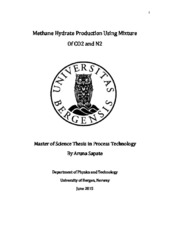Methane Hydrate Production Using Mixture of CO2 and N2.
Abstract
Gas Hydrates (GHs) are naturally occurring solid, crystalline compounds in which natural gas is trapped inside the cage like structures formed by water molecules. Lately a novel technology has been developed for the production of methane from in-situ GHs by injection of CO2. Addition of N2 to CO2 for hydrate production has an advantage of both higher methane recovery and CO2 sequestration. Injected CO2/N2 mixture into in-situ methane hydrate replaces the CH4 molecules in the hydrate cage and form new CO2 dominated CO2 hydrate or mixed CO2-CH4 hydrate. This conversion is based on two primary mechanisms; first is through formation of new hydrate and second is direct solid state exchange. The main goal of this master thesis is to study the feasibility of CO2-N2 gas mixture injection method in methane recovery. In pursuit of this goal hydrate stability limits for different mixtures of CO2/N2 in terms of chemical potentials as function of gradual decrease in CO2 content in gas mixture have been evaluated. The CO2:N2 ratio is a sensitive balance. Nitrogen concentration applied in relevant simulations carried out in this thesis vary from 30% to 80%. Residual thermodynamics has been applied for all the components in all phases as a basis of free energy analysis of hydrate stability in order to have same reference level of chemical potentials for all components in all phases. The kinetics of hydrate phase transition in porous media is implicit function of mass-transport dynamics, heat transport dynamics and the kinetics of the phase transition itself. The work presented in this thesis is a contribution to the description of the thermodynamic forces related to the phase transition kinetics. A natural extension of this work would be the inclusion into a hydrate reservoir simulator in order to complete the couplings to mass and heat-transport. For this reason, as a service to external researchers that might want to incorporate these models into their simulator, a fairly detailed description of the thermodynamic models is presented. As examples for examining possible limitations of nitrogen addition to the carbon dioxide, a selection of real hydrate reservoirs have been examined in terms of local range of thermodynamic conditions for hydrate zones considered to be large enough in thickness and extension of hydrate filled sediments to be of interest for possible production. For this purpose using different concentrations of CO2 & N2, hydrate stability limitations have been evaluated at hydrate bearing layers in Eileen area at Prudhoe Bay field on the North Slope of Alaska, USA; Mallik field at Mackenzie Delta River, Canada; MITI Nankai Trough at Japan and Bjørnøya Basin in SW-Barents Sea. For each study area, regional stratigraphic data for hydrate bearing sediments has been analyzed. The fastest mechanism for conversion of CH4 hydrate through CO2 injection goes through the formation of new CO2 dominated hydrate and subsequent dissociation of in-situ hydrate assisted by the released heat from this new hydrate formation. An important focus of the analysis is the necessary CO2 content in the gas mixture needed for generation of new hydrate. CO2 will dominate new hydrate and will therefore be extracted from the injected gas mixture. A second focus is the implication of a nitrogen dominated gas (after gradual CO2 3extraction) on stability of the hydrates in reservoir, both in-situ CH4 hydrate and new CO2 dominated hydrate. This method of injection of CO2/N2 mixture into in-situ hydrate for CH4 production has been proven beneficial in many aspects over injection of pure CO2 method. The development of such production methods may help us to overcome the environmental issues as well as challenges related to economy recovery. On the basis of simulation results obtained, it seems feasible to produce in-situ methane hydrate by injection of CO2/N2 mixture. In summary the evaluation performed in this thesis indicate that the thermodynamic stability of hydrate depends on temperature, pressure and concentration (corresponding chemical potential) of all components in all phases entering the hydrate in all co-existing phases. The second part of this thesis deals with the evaluation of maximum permissible water content in gas stream while gas is transported through pipelines without facing the risk of hydrate formation. The transport of CO2 to its underground storage destination through pipelines occurs at low temperature and high pressure which favors the hydrate formation. There are several different routes to hydrate formation depending on number of phases containing hydrate formers, but in this master thesis three possible routes of hydrate formation have been evaluated. Simulation results indicate that the most dominant route for hydrate formation is through the adsorbed water on rusty pipeline surfaces and hydrate formers in gas phase. The obtained results also indicate that with addition of N2 to CO2 and with increase in pressure, maximum water content permitted in gas stream during transport through pipeline decreases. Estimated results indicate that the system containing 1/3 CO2 + 2/3 N2, at pressure 170 bar and temperature 222 K, the mole-fraction of water before liquid drop out is 0.85 times higher than the mole-fraction of water before adsorption on hematite.
